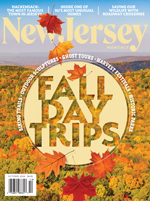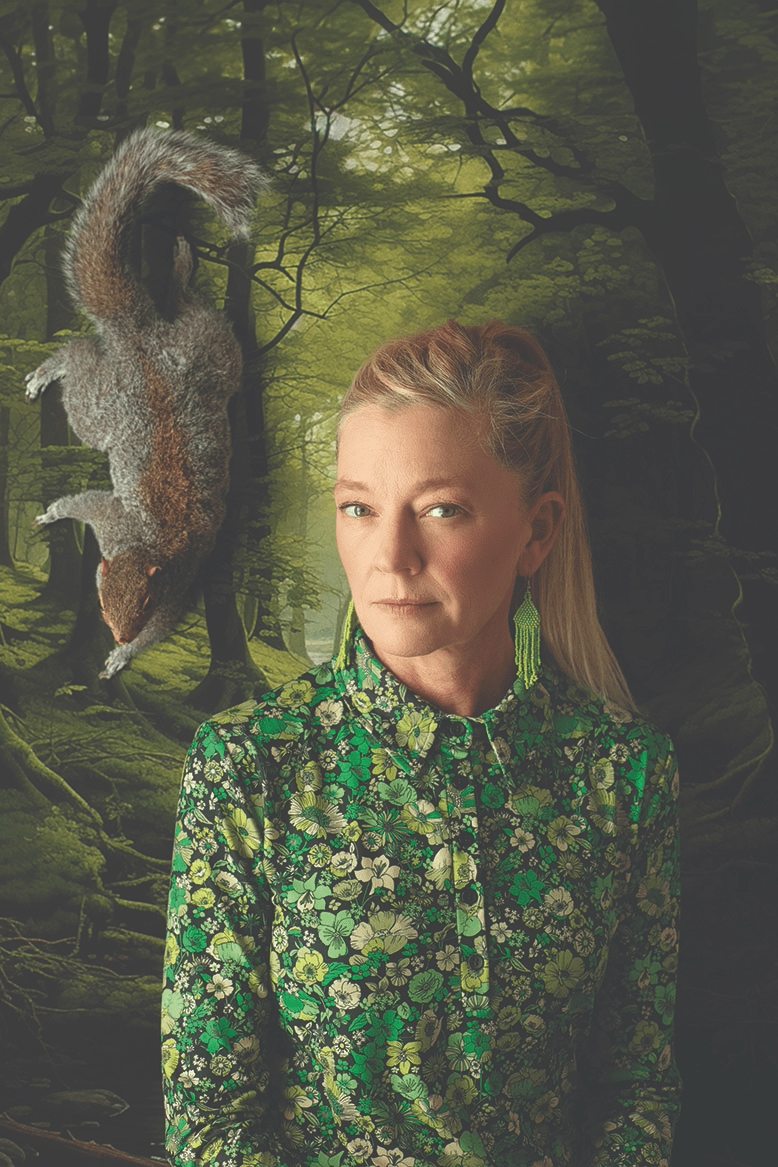
Photographer Kimberly Witham became fascinated by the beauty of animals through taxidermy. Photo: Courtesy of ©Kimberly Witham
When photographer Kimberly Witham moved with her family from New York City to rural Hunterdon County more than a decade ago, she started seeing roadkill on the country roads she drove on from New Jersey to Bucks County Community College in Pennsylvania, where she taught. A lot of roadkill. Soon, the artist in her began to look at the dead animals differently—there was a certain beauty to them. “I was like, What is going on here? I would comment to people, and they would kind of shrug, like they were just so used to it. But I think it was so shocking to come from New York City, where you don’t really see any wildlife, to coming here and being like, God, most of the wildlife I see is dead on the side of the road.”
That, she says, was the genesis of her passion for the art of taxidermy, making dead animals part of her work. “I was like, Well, how am I going to comment on this?” she explains. “The reason I ended up learning taxidermy was I’ve always been kind of fascinated by it, but also because I was taking these creatures back to my studio to incorporate them into my photographs.”
The art of taxidermy isn’t dead—it’s been reborn, and nowadays, it’s even hip. Celebrities like Drew Barrymore and Demi Moore are embracing taxidermy, collecting it and decorating their homes with it, and edgy shops selling taxidermied animals and oddities are starting to pop up with more regularity. But, in contrast with the deer heads that were traditionally found on the walls of hunting lodges and the homes of the wealthy, this taxidermy is often fun and playful, sometimes creepy, and frequently beautiful. And, more often than not, it’s being created by women.
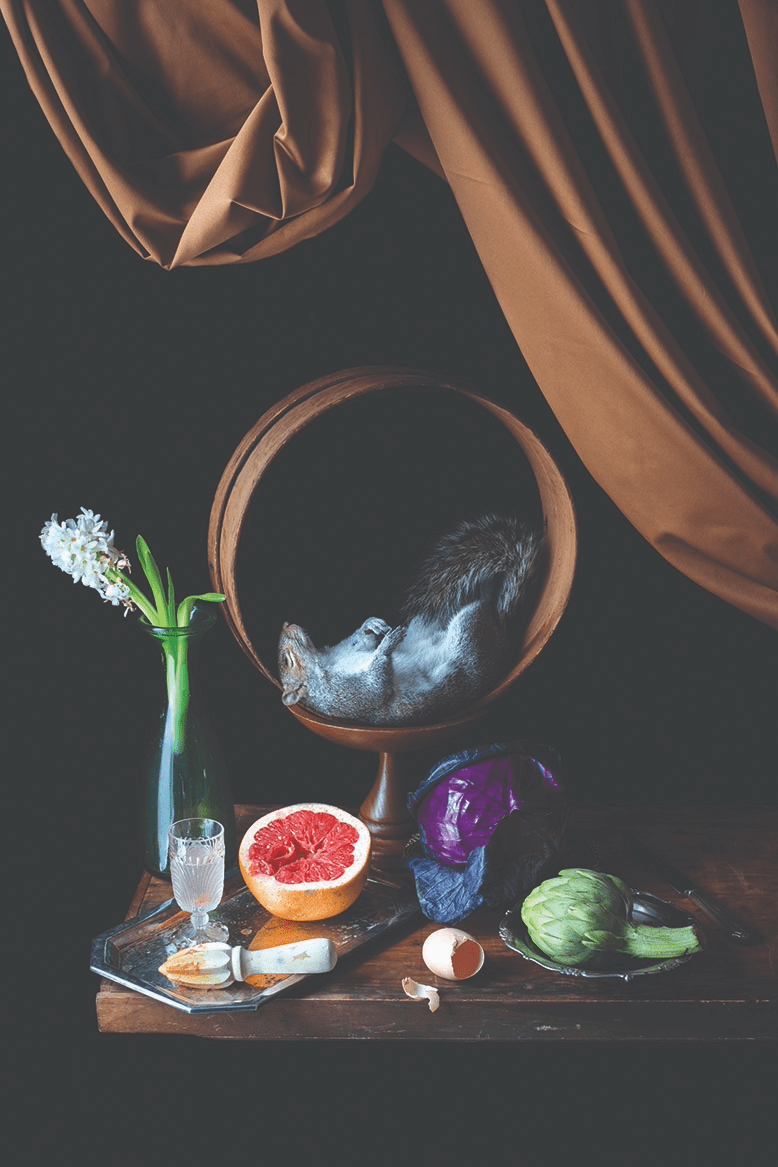
Witham’s Morning Light is inspired by Dutch still-life paintings. Photo: Courtesy of ©Kimberly Witham
Witham’s work, reminiscent of the Dutch masters’ still-life paintings, is gorgeous and disturbing at the same time. A gracious table that’s set for dinner is decorated with a small bird frozen in time; a dead raccoon appears to be slumbering on a platter, surrounded by wine and the remnants of a meal.
In her work, Witham taxidermies the animals and then sets them up in scenes that she photographs.
Taxidermy, a method of preserving animals for display or study, is a curious subculture. It involves mounting an animal’s skin on a model body, so that the animals look alive or in motion. Taxidermists need to know about animal anatomy, and have a knowledge of sculpture and tanning. Traditionally, the practice was used to display animals as hunting trophies and in natural history museums—but today, taxidermy is becoming more popular as a hobby, and more people are collecting it.
As Witham’s interest in the art grew, she decided to attend taxidermy school in Wisconsin. When she arrived, she was the only woman among a group of men who, she says, were right out of central casting—hunters with long beards and lots of flannel.
When she started readying the animals to be mounted, she soon realized that the process is not for the faint of heart.
“It’s insanely visceral,” says Witham, who has lived with her family in Lebanon Township since 2006. “It’s almost like you are undressing the animal. I think people imagine that you’re cutting it open like a surgeon, but you’re not. Imagine that their fur is like a tight-fitting jumpsuit, and you’re taking it off. And so you have to make an incision and then, using a scalpel, you have to slowly peel the skin away.”
The art of taxidermy also intrigued Melissa Milgrom, a journalist who grew up in New Brunswick and wrote the book Still Life: Adventures in Taxidermy (Mariner Books, 2010) to better understand it.
In researching her book, Milgrom spent time with famous taxidermists and even visited the workshop of David Schwendeman, the former chief taxidermist for the American Museum of Natural History, who lived in Milltown until his death in 2012. Much of his work graces the museum, including majestic bald eagles, mink, coyotes and geese.
[RELATED: Meet Woodland Park’s World-Renowned Taxidermist]
Milgrom believes that one of the reasons for a resurgence in taxidermy now is the scarcity of some species of animals, making them more exotic.
“There’s always a resurgence in taxidermy,” she says. “It’s reviled, then it becomes hip again.”
During her research, she learned how to create a mounted squirrel herself.
“It was really gross and difficult. I skinned it, tanned it, and did everything the old-fashioned way,” she says.
She now has two taxidermied squirrels in her home, including the one she mounted, as well as a chipmunk and a crocodile head. “For me, they’re totems of the time I spent hanging out with taxidermists,” she says. “It’s like my own cabinet of curiosities.”
As the appeal of taxidermy has started to broaden, more women tell us they are getting in on the act.
Jessica Drago, who lives in Nutley, is one of them. She became enamored with the art of taxidermy about a year ago after seeing an Instagram post showcasing a woman producing a mounted bird. Drago, a 31-year-old artist who started out making wildlife sculptures, knew then that taxidermy was something she wanted to try.
ETHICAL TAXIDERMY
Like many other taxidermists working today, Drago uses only animals that have died of natural causes, a practice called ethical taxidermy. At the moment, she’s concentrating on birds. Her studio, which is in her apartment, has many of the colorful, delicate mounted birds that she has created in the past year, including cockatiels, goldfinches, and her favorite, the multicolored Gouldian finch.
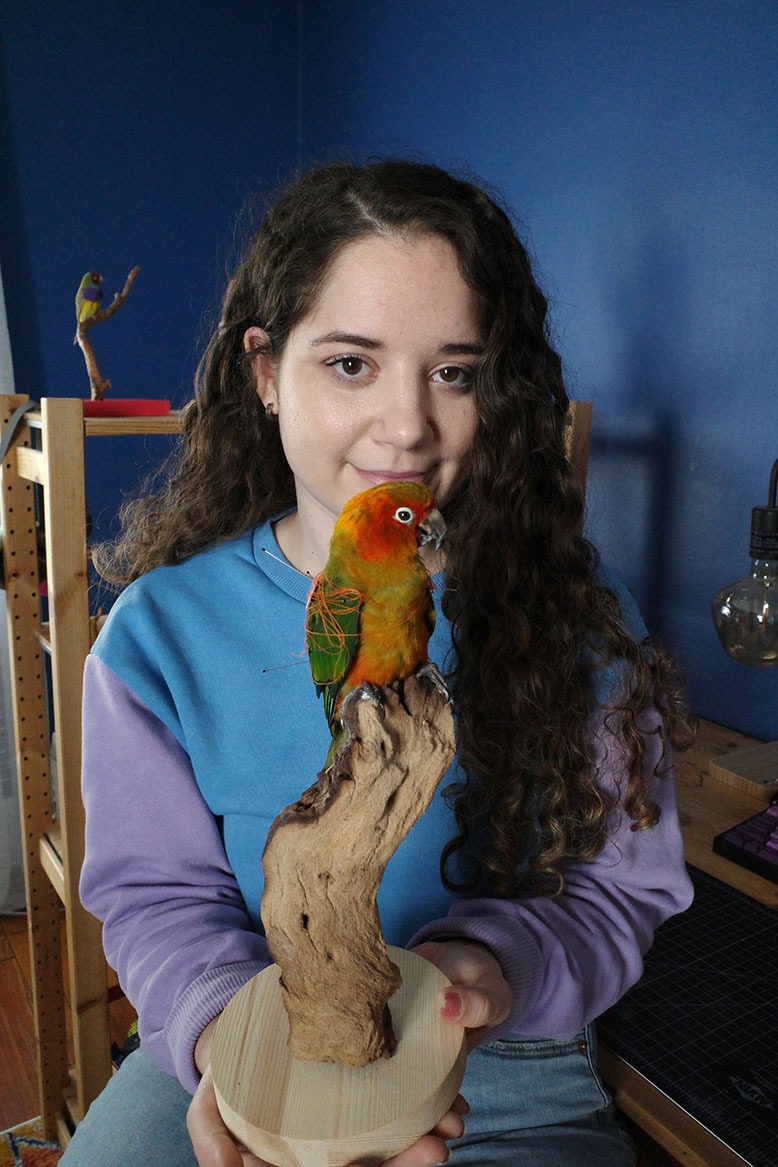
“It’s weird because I don’t see the animals as dead,” says 31-year-old artist and taxidermist Jessica Drago. “A big part of why I do what I do is to breathe new life into them.” Photo: Courtesy of Mario Cordaro
She obtains them in various ways, mainly through breeders and pet shops, which send her birds that have died. She spends between $10 and $50 for these birds; her finished birds sell for $200-$300 in stores.
While most animals found dead on the street may be used for taxidermy, the laws in the United States regarding the use of birds for taxidermy are extremely strict. Many wild birds, even dead ones, are protected under the Migratory Bird Act. However, some non-native species, such as house sparrows and starlings, are exempt from the law.
When she first started out, Drago says, she once picked up a dead starling on the street and took it home to work on it, only to discover it was too decayed for taxidermy. “It has to be fresh enough to eat, but it can’t have a smell to it. And if the feathers fall out, it’s too far decayed and not suitable,” she explains.
That starling was her first—and last—roadkill experience, she says. Drago later found a pest-control company that agreed to give her starlings they removed from buildings. She also found a taxidermist in Connecticut who was willing to give her some of her birds because she needed more space in her freezer.
Drago also keeps some of her birds in her own freezer, right next to the hamburger patties. She says her fiancé, whom she lives with, doesn’t mind and has been extremely supportive of her work.
On her desk in her studio are some of the tools she uses in her taxidermy, including a steel brush for removing excess fat that is left on the skin between the feather quills. In taxidermy, the organs of the animal are not removed; rather, the animal is skinned and the carcass is removed. Then, the skin is placed over a fiberglass form to create the mounted animal. Glass eyes can be purchased online.
“The process could be a little shocking to someone if they’re not expecting it,” she says. “You have to make an incision down the center and make a few separations of the legs, the tail and the wings. Then you cut them off. You basically have to get the skin and the bones very, very clean. And then you use wire and string to kind of put it back together.”
Still, after her first taxidermy experience, with a chick, she couldn’t eat meat for a while. “But now it’s very easy for me,” she says. Drago believes that more women are getting into taxidermy because they’re seeing other women doing it—and succeeding. “The reason why I keep going is because I found teachers online that are also women. And now I’m at a point where I’m getting contacted by other women all the time who are also interested in learning,” she says. “I think that what’s happening is really special. There’s a lot to learn from taxidermy: It’s art, it’s nature, and there’s also a conservation aspect to it.”
A LOVE FOR ANIMALS
Drago was drawn to taxidermy because it combined her love for animals with her background as an artist.
“It’s weird, because I don’t see the animals as dead. A big part of why I do what I do is to breathe new life into them. And I really wanted to learn more about birds, so I thought this was also a really good way to do that as well,” she says.
Drago has been selling some of her mounted birds to Paula Lopez, who recently opened a store in Montclair called UnLucky Rabbit, where she sells taxidermy, curiosities and oddities, and also offers tattooing.
Lopez’s shop focuses on artistic taxidermy—with quirky tableaux of animals in unusual and unexpected positions—and caters more to the collector than the hunter. For instance, she has a taxidermy rat in a bathtub talking on the phone, a groundhog perched in a bed of flowers, and a cowboy duckling wearing a hat. Prices range from $150 for small birds up to $1,000 for some bigger pieces.
The difference between artistic and traditional taxidermy, she says, is that rather than focusing on deer and other animals that are hunted, her store showcases animals that aren’t typically associated with taxidermy, such as squirrels, bats and foxes. Lopez also sells oddities, such as a mink purse with the legs and tail of a mink attached. “We don’t kill anything on purpose. Everything is repurposed,” Lopez says. “We consider taxidermy as the ability to make animals come alive again for people to enjoy them.”
Sometimes, Lopez says people inquire about having their pets mounted, but that is considered especially challenging for taxidermists because it’s difficult to get the animals’ expressions just right.
Lopez believes there’s been a resurgence in taxidermy because it’s now being viewed more as artwork than as a trophy to hang on the wall. “I always loved animals, and I really like the idea of being able to preserve them and look at them and love them,” she says. “We really try to bring out the essence of the animal in our pieces.”
She continues, “I have lots of pets, and terrible as it sounds, they don’t have permanence. But with taxidermy, they can literally last forever.”
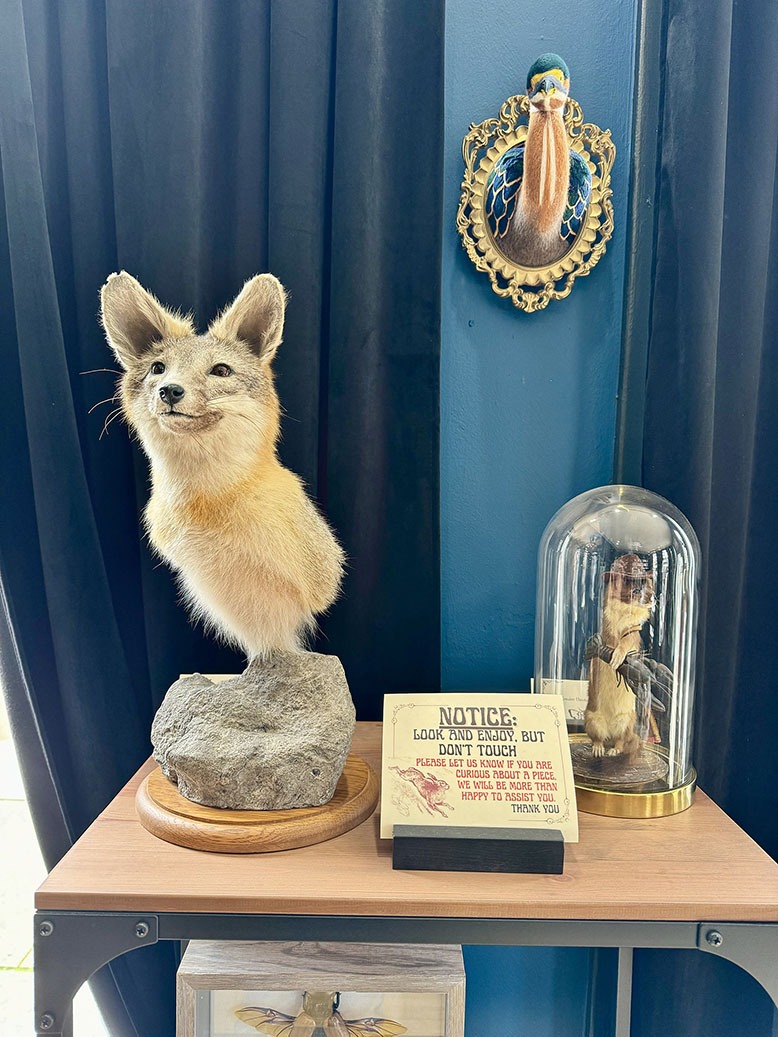
UnLucky Rabbit in Montclair Photo: Gail Ghezzi
And more celebrities are becoming enamored with taxidermy. Last year, the actress Demi Moore gave herself a taxidermied baby donkey for her 60th birthday; Wes Anderson, Amanda Seyfried, Angelina Jolie and New Jersey native Martha Stewart are also enthusiasts. Lopez says she’s even run into Drew Barrymore at taxidermy shows.
While taxidermy isn’t for everyone, it’s definitely becoming more mainstream.
As Lopez says, “It’s really funny, because we get two types of reactions walking into the store. People either love it and are like, ‘Oh my God, what a beautiful piece of art,’ versus the other response, [which] is like, ‘Oh my God, poor thing.’ And I’m like, ‘But why poor thing?’ The misconception is that we go out and kill them. But we don’t.”
“Most people who are into taxidermy love animals more than any other people that I’ve ever met in my life. They will stop on the side of the road to help an animal way before anybody else would. We are literally giving the animal an afterlife, and we get to enjoy them for a very long time,” Lopez says.
No one knows New Jersey like we do. Sign up for one of our free newsletters here. Want a print magazine mailed to you? Purchase an issue from our online store.
